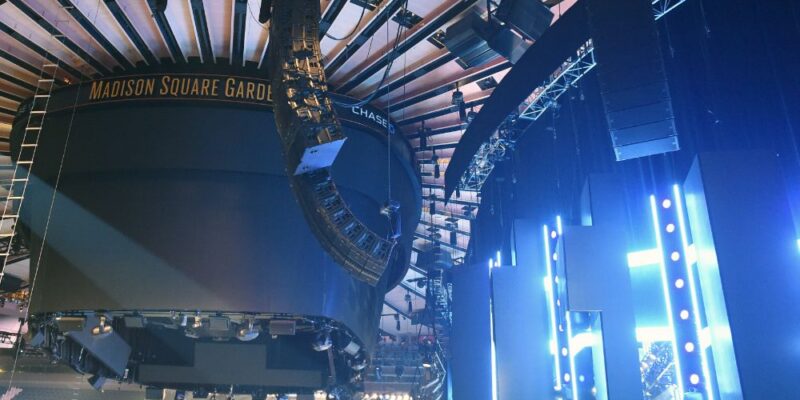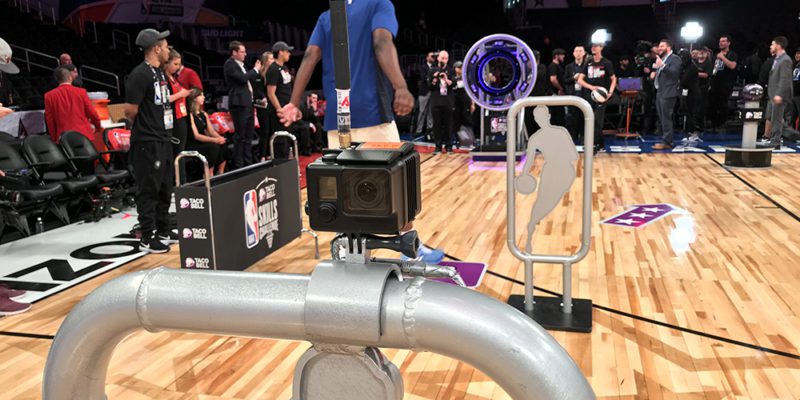Courtesy of Jason Dachman via Sports Video Group
Next-gen technologies offer new ways to view the action
This weekend, NBA All-Star festivities once again serve as a showcase for Turner Sports’ tech-savvy production efforts on the hardcourt. As the gem of Turner’s annual NBA calendar for more than decade and a half, All-Star Weekend continues to be a launch pad for next-gen technology and production workflows. This year in Los Angeles, Turner’s bag of tech toys includes an RF pylon cam on tonight’s Skills Challenge, shot-tracking technology for the Three-Point Contest, and an even more intricate ecosystem inside its already massive truck compound.
“NBA All-Star really shows what we can do,” says Chris Brown, senior director, technical operations, Turner Sports. “We definitely have a few cool new [production tools] here, but, in terms of the compound, we try not to mess with the secret sauce. We’ve found a [workflow] that works really well for us, so we are just trying to build on that each year. And the fact that we are lucky enough to do this every year means we get to push ourselves every year to innovate and make it better. It’s a lot of fun.”
All-Star Saturday Night: Providing New Perspectives
The raucous atmosphere of All-Star Saturday Night tips off with the Skills Challenge, and fans will have a new perspective in the three-round, obstacle-course competition, in which the players will dribble down the sidelines, weaving in and out of pylons. Turner has worked with AVS to deploy an RF camera featuring a GoPro/Vislink Herocast miniature camera that sits atop two of the pylons.
“It is going to provide a very cool ‘coming at you’ perspective as the athletes race down [the course],” says Brown. “It’s something we’ve been working with AVS on for quite a while, and then we adapted it a bit with GoPro. It’s mounted right on top of the pylon and should provide an angle that people haven’t seen before.”
The pylon cam will be just one of a whopping 48 cameras deployed by Turner during the weekend for the All-Star Game, All-Star Saturday Night, Inside the NBA studio sets, and NBA on TNT Road Show concerts throughout the weekend, including two additional RF cameras (also from AVS) and six robos (from Fletcher).
The pylon camera won’t be the only new tech at Staples Center tonight; Turner has teamed with Israeli startup RSPCT Basketball Technologies and SMT to deploy a new shot-tracking system for the Three-Point Contest. Data from RSPCT’s system, which uses sensors attached to the backboard and high-resolution cameras to track the ball in flight and identify exactly where it hits the rim/basket, will be integrated with SMT’s augmented-reality graphics system to offer fans a deeper look at each competitor’s shooting accuracy and patterns.
“This system is going to give the production [team] a chance to show shot accuracy in rapid-fire succession,” says Brown. “We worked with RSPCT to integrate their system with SMT, and I think the [result] is going be great for fans.”
Inside the Compound: ND1 the Heart of the Production
Turner’s truck compound this year is located at the top of the steps of the L.A. Convention Center and comprises 13 total mobile units, which arrived on Feb. 8 — more than a week before All-Star Weekend. NEP’s ND1 (A, B, C, and D) is once again at the core of the compound, serving as the audio- and video-routing/distribution center for the entire show.
“[Our use] of ND is continuing to evolve,” Brown observes. “This year, ND1 is coming straight off [serving as NBC’s A unit for] the Super Bowl. So my hat’s off to the NEP team [for bringing] that truck straight from Minneapolis, where it performed a more traditional role, right to here, where we basically pulled the truck apart and are using it several different ways.”
ND1’s B unit serves as the primary distribution point for the entire compound. All camera and audio feeds are fed into ND1 for distribution to the various trucks in the compound. Thanks to ND1’s robust fiber connectivity, the A, C, and D trucks can also serve as signal-distribution points for other trucks, shortening the length of cable runs throughout the compound.
In addition, Turner is using ND1 for a variety of other needs, including submixing in the B unit’s audio room and transforming the C unit’s EVS replay area into “edit central” to handle its extensive file-based workflows.
“We are going all the way back three years now with the use of ND1, and it was a bit of a crazy idea at first,” says Brown. “But, now that we’ve gotten to the point where we are, I don’t think there’s an easier or more efficient way to do this.”
In addition to ND1, NEP’s SS24 (A, B, and C) served as the primary game-production truck for last night’s Rising Stars Game and the NBA All-Star Game today; NCP10 (A and B) will cover tonight’s festivities. Throughout the weekend, NCP11 will serve as home to the Inside the NBA onsite studio show. SS16 and ATU are onsite for the entertainment and halftime-show elements, and Cobalt is handling the Turner-Intel virtual-reality production.
NBA on TNT Road Show Returns With Inside the NBA Onsite
As has become customary for All-Star, Turner Sports has pulled out all the stops with a massive fan-fest in Downtown Los Angeles. The 30,000-sq.-ft. NBA on TNT American Express Road Show is located at L.A. LIVE just outside the Staples Center and serves as home to live telecasts of TNT’s Inside the NBA studio show, as well as concerts Thursday, Friday, and Saturday (Lil Uzi Vert, Kendrick Lamar, and The Killers, respectively) and a host of fan activations.
Inside the NBA uses the onsite set for live pregame, halftime, and postgame coverage every Thursday through Sunday. Although Inside the NBA also has a set inside Staples Center, the bulk of the All-Star studio programming is originating from the Road Show set.
Turner has deployed six cameras to cover the Road Show area. The Turner Sports broadcast team produced the Thursday-night concert, and the Turner Live Events Team and the Solomon Group are handling the Friday and Saturday concerts.
“I also have to give a lot of credit to the folks at the Staples Center and the amount of connectivity that the Staples Center and AEG provide to be able to make all this happen,” says Brown. “Between the interconnected tunnels and the amount of fiber strands, the infrastructure that Staples Center and AEG have put in in this space is amazing. Getting to all these different locations is not easy, but they’ve been great to work with through all of this.”
File-Based Workflows: From L.A. to Atlanta and Back
Turner’s file-management team is out in full force in L.A. and has a 1-Gbps data circuit to Turner Sports’ Atlanta headquarters dedicated to the file-based workloads.
In all, Turner will move more than 15 TB of content throughout the course of the week and has a whopping 190 TB (100 TB SAN, 90 TB NAS) of local storage available for the onsite library to support movement of content between Atlanta, its Thumbwar editing system onsite (70 TB of SAN storage), and graphics (10 TB of SSD NAS). A total of 14 edit workstations onsite are supporting the TNT linear telecasts, NBA Entertainment, various social-media productions, and studio shows.
“We have our file-management team out here, and they have really grown this [operation] a lot over the past few years,” notes Brown. “Our entire EVS network and edit operation are interconnected, and we’ve worked very closely with our vendor Thumbwar to make sure [that is the case]. They’ve been a tremendous partner for a number of years now, helping us support these file-based workflows.”
Leveraging Firehouse Productions Mics, Comms
Turner also continues to expand its integration with the Firehouse Productions audio and communications infrastructure deployed inside the arena at All-Star each year. The hard-wired comms system — serving NBA Entertainment, some TBS positions, and the in-arena production — consists of eight Riedel nodes: six Artist 64 frames, one Artist 128 frame, and one Artist 32 frame. In all, the system serves 209 distinct users, including intercom panels, C3 beltpacks, and Bolero beltpacks. Firehouse is also dropping MADI kits at all of Turner’s primary trucks, making it easier to share and distribute audio throughout the compound.
“We’ve begun to leverage even more of Firehouse’s infrastructure from microphones and two-wire intercoms inside the building and on the floor,” says Brown. “It used to be a massive undertaking on our side to distribute all of that. But now we are more tightly integrated with Firehouse to assist in the distribution of the two wires across the floor and lots of the microphones that we use, particularly the shared house mics. It has become much easier.”



